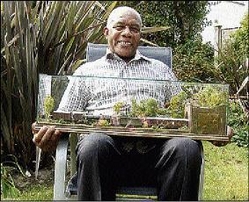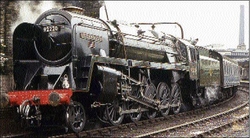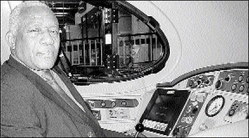
Donald Sewell shows off a model train.
DONALD SEWELL is a legend. He has driven more types of trains than most current train employees ever will. And after 48 years in the industry, his knowledge of the railway is impeccable.
The 65-year-old started working on the trains when he was 17, just months after he left St Catherine, Jamaica, to join his parents in north England.
In 1961, he saw an advertisement for a railway fireman in the Lancashire Evening Post.
"What you had to do was shovel the coal to throw in the firebox to steam this big steam engine," Sewell recalled.
His first engine fireman job was with a depot in rural Preston, Lancashire, where many white people had never seen a black person before.
"As a black man, wherever you went people stared at you," Sewell said.
He would travel to places like Carlisle, 90 miles from Preston. "You'd step off the trains and people would turn around to look. You felt a bit intimidated, but you did what you had to," Sewell said.
He spent 36 years with the old British Railway, moving up from railway fireman, a role he held for eight years, to eventually becoming a driver in 1968.
It is one of his proudest moments, because back then wor-kers became drivers in stages and by promotion, instead of just applying directly for the role as happens today.

Steam locomotive, Evening Star: Sewell started his career driving trains like this. - ASLEF Photo
"It was an achievement," Sewell said.
The father of five, who has been married to wife, Doris, for 33 years, moved from Lancashire to London in 1968 and was one of only four black workers out of 600 firemen and drivers at Euston station.
While he saw racism at work through a few white colleagues' comments, he said, "It was never thrown in my face. Nobody ever called me names."
Sewell drove steam trains for six months in 1968, just before they were phased out. In fact, he was one of the last steam engine train drivers.
In the 40 years since then, Sewell has driven nearly every type of engine, including diesel, electric and Pendolino trains.
Early journeys
He recalled the early journeys where, as a young fireman, he and the train driver would have to book a hostel and stay overnight because it could take up to 12 hours for a steam freight train to travel 90 miles.
It took that much time because train speeds were slower and the railway would hold back freight trains to let the faster passenger trains go first.
"I grew to love the job," Sewell said. "It took me all over the country. In addition, the driver is seeing everything in front of him, and that's a wonderful scene, especially when you go through the seasons.
"Between Stoke and Manchester in the wintertime, it's picturesque. When you get the snow on the trees and on the leaves, it's absolutely beautiful."
Among his favourite memories is driving the Royal Train, carrying the Queen from Bletchley in 1979.
"At that time, you had the royal secretary, who would send you a cheque for what you had done, and that was £2.50. I should have framed that letter," he said.
But the job had its challenges, especially in the old days when thick fog and smog from coal-burning factories and homes obscured the route.
"With that, sometimes, you stretch your arm out and you can't see it," he said.
In fog, he sometimes could not see the semaphore signals, manual wooden signals without lights, far different from the modern, sophisticated traffic light and bell-ringing signalling systems.
Be creative
He said drivers would have to stick their heads out of the window and tread slowly, feeling their way along.
Or sometimes drivers had to be creative, like hang a toolbox on the signal - when it fell and made a noise they would know to go.
The long journeys - and 2 a.m. shifts - often made planning time with his family difficult.
"You never knew what time you would get off so you could only make plans on your day off," he said.
"My wife worked the shifts with me. I have to thank her. She's put up with a lot."
Sometimes his wife stayed up until 1 a.m. to wake him up so he could get to work for 2 a.m., Sewell said.
He has seen many changes, including wages (he started at £10 a week) and conditions, work shifts - starting now at 4 am. - and railway privatisation in 1996.
Retirement
From 1996 to his February 2009 retirement, Sewell worked with Virgin Trains, where he is known for his pristine uniform and shiny shoes, which he polished daily.
On his retirement, his colleagues made and gave him a model steam engine. "Virgin is a good boss to work for. I loved working with the guys at Euston. They are absolute gems. We've had some fun times," Sewell said.
Sewell's wife and children held a retirement party for him. He was also profiled in his union, ASLEF's (Associated Society of Locomotive Steam Enginemen and Firemen), magazine.
He is enjoying retirement. "I've done my share; 48 years is a long time," he said. "I am relaxing for the time being. It's a good feeling knowing that you can get up when you want. I do a bit of gardening and cooking. I am going to learn how to use the computer," said Sewell.
He also plans to spend more time with his 13 grandchildren, and is thinking of making his home near a Jamaican beach.
"It's still my dream," he said, grinning.


Donald Sewell in the driver's seat. - ASLEF Photo